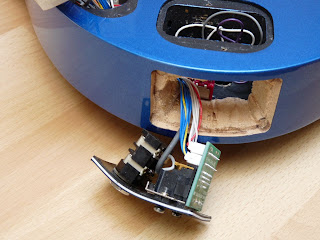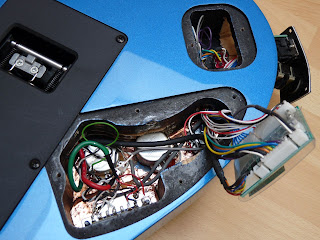 |
| Original Ibanez RG870 |
 |
| Ibanez RG870 Cavities |
 |
| Working out the output plate dimensions |
This next operation took the longest of all, not because it's particularly difficult, but because I had to pluck up the courage to attack my new guitar with a router. To ensure the router went where it was supposed to go I decided that some form of guide was essential. I marked out and cut two sides from MDF and joined them together using thin plywood which had an opening of the required size cut into it. I then protected the guitar body with masking tape before clamping the guide into position.
 |
| Router guide clamped in position |
 |
| Rout for plate completed and plate bent to shape |
 |
| Hole cut through to cavity |
 |
| Two multiways go to the sockets + wiring to jack socket and switches |
Because Ibanez had already provided a nice, wide cavity for the jack socket it was possible to fit both the up/down push switches and the output select toggle into the existing space. Having drilled the holes, I inserted the switches in their respective positions and then tried fitting the plate with the two sockets on. It was at this point that I realised the original Ibanez jack socket was clashing with the selector switch. A quick search in my spares box found a much shorter socket and I used this instead.
Time to get the soldering iron out and make the common connections between the switches and then the lead to the jack socket. This proved quite tricky. You will need a soldering iron with a fine tip and a steady hand. The rest of the wiring can then be threaded through the hole between the cavities, the final connections to the selector switch soldered and multi-pin connectors snapped into place. There's also the synth volume control to be added into the main cavity and plugged into the PCB.
 |
| Synth/Guitar selector switch wiring |
 |
| Main cavity wiring |
The wood between the rear humbucker cavity and the rout for the tremolo system is 8mm, exactly the same as the pickup. Once I'd refitted the tremolo block and restrung I found that the pickup could be screwed directly to the guitar body without any need for packing but I think I may need to review this once I'm properly set up. Looks like I might need to bring the pickup up a few mil.
Here's the completed project.
 |
| The finished Ibanez RG870 |
In many ways the RG870 has proved to be the ideal guitar for adding the Roland pickup to. It has not required any additional cavities to be routed and therefore no new backplates. The existing jack socket cavity is large enough for installing the switches and there is just the right amount of space for the new pickup. The main cavity has plenty of room for the additional volume control and the Roland PCB just fits in.
 |
| RG870's in GuitarGuitar, Epsom |


No comments:
Post a Comment